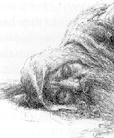23 Number words
Cardinal numbers
0..cúma (literally: “void”)
1… minë
2… atta
3… neldë
4… canta
5… lempë
6… enquë
7… otso
8… tolto
9… nertë
10. quain
The numbers 11 to 19 are made with the suffix –quë :
11. minquë
12. yunquë
13… nelequë
14… canaquë
15… lepenquë
16… enenquë
17… otoquë
18… toloquë
19… neterquë
The multiples of 10, thus 20 to 90, are constructed with the suffix –quain:
20… yuquain
30… nelquain
40… canquain
50… leminquain
60… enenquain
70… otoquain
80… toloquain
90… neterquain
100.. tuxa
To make a number that is not a multiple of 10, we first write the units and then afterwards the multiple of 10 (to speakers of German, Dutch or Danish, this is very familiar):
Example: 54… canta leminquain
The numbers between 100 and 200 can be made in the same fashion:
140… canquain tuxa
172… atta otoquain tuxa
The numbers 110 and 120 can be written in two different ways:
110… quain tuxa / minquequain
120… yunquain tuxa / yunquequain
To write the numbers 200 to 900 we use the same prefixes as the multiples of 10, but this time with the suffix –tuxa:
200… yutuxa
300… neltuxa
400… cantuxa
etc.
We also know the number words:
1000… húmë
1 million… mindóra
There is still one strange feature of the number words from 20 upwards; when these number words are followed by a noun, the noun is in the partitive plural.
Examples: nelquain roccoli (thirty horses), tuxa ciryali (one hundred ships)
Ordinals
The first ordinals are irregular:
minya (first)
attëa (second)
From three until ten we remove the last vowel of the cardinal number and add –ëa:
neldë (three) -> neldëa (third)
canta (four) -> cantëa (fourth)
lempë (five) -> lempëa (fifth)
enquë (six) -> enquëa (sixth)
otso (seven) -> otsëa (seventh)
tolto (eight) -> toltëa (eighth)
nertë (nine) -> nertëa (ninth)
quain (ten) -> quainëa (tenth)
minquë (eleven) -> minquëa (eleventh)
yunquë (twelve) -> yunquëa (twelfth)
For “half” we have the word “perya”.
Quotientials
There also exists quotientals that are used when something has happened a certain number of times. They are used as adverbs:
eru (once)
yú (twice)
nel (thrice, or, three times)
can (four times)
The higher numbers ar formed with the suffix –llumë:
lemillumë (five times)
enquellumë (six times)
cëallumë (ten times)
tuxallumë (one hundred times)
***
Vocabulary list 23
ohtar “soldier”
túrion (túriond-) “palace”
corda “temple”
masto “village”
máma “sheep”
ento “next to”
nyellë “bell”
mindo “tower”
nárë “flame”
tir- “guard, watch over”
yén “year”
culusta “gold coin”
manca- “trade”
ranya- “wander”
nor- “run”
lenda “journey”
acca “too”
er “only, but, still”
ranga “pace” (measure of distance, 38 inches or 96.5 cm)
lár “league” (measure of distance, equals 5000 ranga, approximately 5278 yards or 4826 m)
***
Tengwar numbers
Let’s look at the digits in tengwar:
Some remarks:
- The tengwar numbers are always written from right to left.
- Originally the numbers had to be written in the duodecimal number system (based on the number 12 instead of the number 10). That’s why there are digits for 10 and 11. These tengwar for 10 and 11 are in modern Quenya only used to number chapters and pages and so on.









